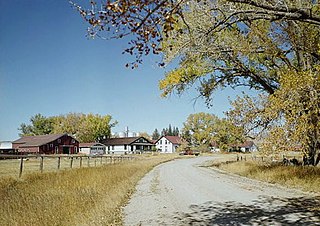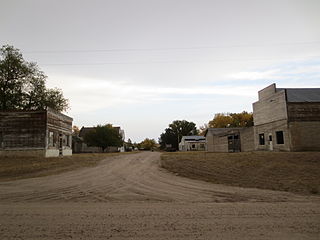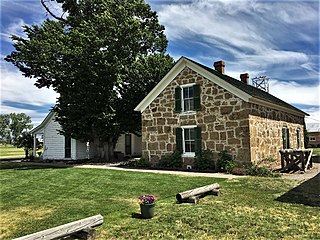The Ucross Foundation, located in Ucross, Wyoming, is a nonprofit organization that operates an internationally known retreat for visual artists, writers, composers, and choreographers working in all creative disciplines.

Tom Sun Ranch, also known as Sun Ranch, is a historic site along the old Oregon and Mormon trails, about 6 mi (9.7 km) west of Independence Rock, Wyoming on Wyoming Highway 220.

The Swan Land and Cattle Company Headquarters are a historic ranch headquarters complex on Wyoming Highway 313 in Chugwater, Wyoming. Organized in 1883 in Scotland, the Swan Company was one of the largest ranching operations in the nation in the late 19th and early 20th centuries, managing more than one million acres of land. Now a much smaller operation, its former headquarters complex was declared a National Historic Landmark in 1964.

The 4 Lazy F Ranch, also known as the Sun Star Ranch, is a dude ranch and summer residence in Jackson Hole, Wyoming, built by the William Frew family of Pittsburgh in 1927. The existing property was built as a family retreat, not as a cattle ranch, in a rustic style of construction using logs and board-and-batten techniques. The historic district includes seven cabins, a lodge, barn corral and smaller buildings on the west bank of the Snake River north of Moose, Wyoming. The property was added to the National Register of Historic Places in 1990.

The TA Ranch was the site of the principal events of the Johnson County Range War in 1892. The TA was established in 1882 as one of the first ranches in Johnson County, Wyoming. The TA is the only intact site associated with the range war, with trenches used by both sides still visible and scars on the nearby buildings. The ranch also documents the expansion and development of cattle ranching in Wyoming.
The T E Ranch Headquarters, near Cody, Wyoming, is a log ranch house that belonged to buffalo hunter and entertainer Buffalo Bill Cody (1846–1917). The house may have originally been built by homesteader Bob Burns prior to 1895, when Cody acquired the ranch. Cody expanded the ranch to about eight thousand acres (32 km2), using the T E brand for his thousand head of cattle.

The Vee Bar Ranch Lodge was built in 1891 as the home of Lionel C.G. Sartoris, a prominent Wyoming rancher. The ranch was later owned by Luther Filmore, a Union Pacific Railroad official, and the Wright family, who operated the ranch as a dude ranch. The property comprises five historic buildings including the lodge, original corral and a stock chute.

This is a list of the National Register of Historic Places listings in Big Horn County, Wyoming.

The Jay Em Historic District comprises the abandoned center of the village of Jay Em, Wyoming. The town was planned and established by Lake Harris between 1912 and 1915 as a service town supporting ranchers in the surrounding area. The place was recognized as a town in 1915 when a post office was established. Tours of the site are available by appointment.
The Fort Laramie Three-Mile Hog Ranch was built to serve as a social center away from the soldiers' post at historic Fort Laramie. Fort Laramie was a 19th-century military post in eastern Wyoming. It became notorious as a place for gambling and drinking, and for prostitution, with at least ten prostitutes always in residence. The location is notable as an example of one of only a few military bordellos still standing in the United States by 1974, the time of its nomination to the National Register of Historic Places The Fort Laramie site was one of a number of so-called "hog ranches" that appeared along trails in Wyoming.
The HF Bar Ranch is located in Johnson County, Wyoming about 20 miles (32 km) northwest of Buffalo, Wyoming in the foothills of the Bighorn Mountains near Saddlestring, Wyoming. The ranch is a working cattle ranch comprising about 36 buildings, built between 1898 and 1921. The ranch is associated with Wyoming state senator and U.S. Congressman Frank O. Horton, who purchased it in 1911 with financial help from his investment banker brother-in-law and sister-in-law, Warren and Demia Gorrell. The Gorrells and their children spent summers in Wyoming, while the Hortons stayed year-round.

The Dangberg Home Ranch Historic Park is a Douglas County, Nevada, USA, park, preserving one of the state's first ranches.

The Circle Ranch, also known as the R.L. Miller Ranch has been continuously operated as a working cattle ranch for more than 100 years. Located in Sublette County, Wyoming, it was first occupied as a homestead by Otto Liefer between 1878 and 1880. Liefer sold his claim to James Mickelson in 1895, who developed the ranch into one of the largest ranching operations in the area. The ranch has remained in the Mickelson family ever since.

The historical buildings and structures of Grand Teton National Park include a variety of buildings and built remains that pre-date the establishment of Grand Teton National Park, together with facilities built by the National Park Service to serve park visitors. Many of these places and structures have been placed on the National Register of Historic Places. The pre-Park Service structures include homestead cabins from the earliest settlement of Jackson Hole, working ranches that once covered the valley floor, and dude ranches or guest ranches that catered to the tourist trade that grew up in the 1920s and 1930s, before the park was expanded to encompass nearly all of Jackson Hole. Many of these were incorporated into the park to serve as Park Service personnel housing, or were razed to restore the landscape to a natural appearance. Others continued to function as inholdings under a life estate in which their former owners could continue to use and occupy the property until their death. Other buildings, built in the mountains after the initial establishment of the park in 1929, or in the valley after the park was expanded in 1950, were built by the Park Service to serve park visitors, frequently employing the National Park Service Rustic style of design.

Cedarvale, also known as Hillsboro Ranch, was a dude ranch and working ranch in Carbon County, southern Montana, United States. The ranch was established about 1903 by prospector Grosvener W. Barry on the South Fork Trail Creek. Barry used the ranch as a home for his family and as a base for his mining ventures, all of which failed. His most lucrative venture was the conversion of Cedarvale from a working ranch to a dude ranch, marketed through an arrangement with the Chicago, Burlington and Quincy Railroad. It was the first dude ranch in the area. Barry introduced powered boats to the Bighorn River to carry dudes to the ranch from the railhead at Kane, Wyoming. As a publicity stunt Barry, his stepson and a neighbor piloted the 16-foot (4.9 m) motorized Edith from the Hillsboro landing down the Bighorn, Yellowstone, Missouri and Mississippi rivers, leaving on May 31, 1913 and arriving in New Orleans on August 1. One of Barry's boats, the Hillmont, is on display at Barry's Landing.

The George Ferris Mansion in Rawlins, Wyoming is one of the most significant Queen Anne style buildings in Wyoming. Built during 1899–1903, the house's design was published by the Knoxville, Tennessee architectural firm of Barber and Klutz in an architectural pattern book. The house was built for George and Julia Ferris.
Ucross is an unincorporated community along the Piney Creek on the southern edge of Sheridan County, Wyoming, United States. Ucross is located at the junction of U.S. Route 14 and U.S. Route 16, 9.6 miles (15.4 km) west-southwest of Clearmont.

The Oxford Horse Barn, built in 1887, is located near Laramie, Wyoming in Albany County, Wyoming. It is one of the oldest and largest existing barns in Albany County. The barn in an excellent example of vernacular architecture as influenced by the English cattle and horse ranchers which immigrated to the American West. It is listed on the National Register of Historic Places.

The EBF Bridge over Powder River is a bridge located near Leiter, Wyoming, which carries Sheridan County Road CN3-269 over the Powder River. The 201.5-foot-long (61.4 m) bridge has two spans: the first span is a Pratt through truss, while the second span is a Warren truss. Due to this configuration, the bridge has been called "one of [Wyoming's] more interesting vehicular trusses." The trusses in the bridge are connected rigidly rather than by pins; the bridge was built in a transitional period between the two designs and is an early example of rigid connections. The Gregg & Stout Bridge Company of Sheridan built the bridge in 1915.
The Steele Homestead is a historic homestead located along Wyoming Highway 191 northeast of Boulder, Wyoming. The homestead was established in 1886 by Ed P. Steele, who built a one-room cabin at the site; this cabin was expanded several times until it grew to eight rooms after a 1908 addition. Steele and his family operated and added land to the ranch until it reached a peak of 3,000 acres (1,200 ha); by this point, the Steeles owned 600 cattle and 100 horses. Meanwhile, the ranch continued to add buildings, including a main barn and several sheds; it now has seventeen buildings, fourteen of which are contributing buildings to its National Register listing. Steele's children all stayed in the ranching business, and the homestead is still owned by his descendants.















